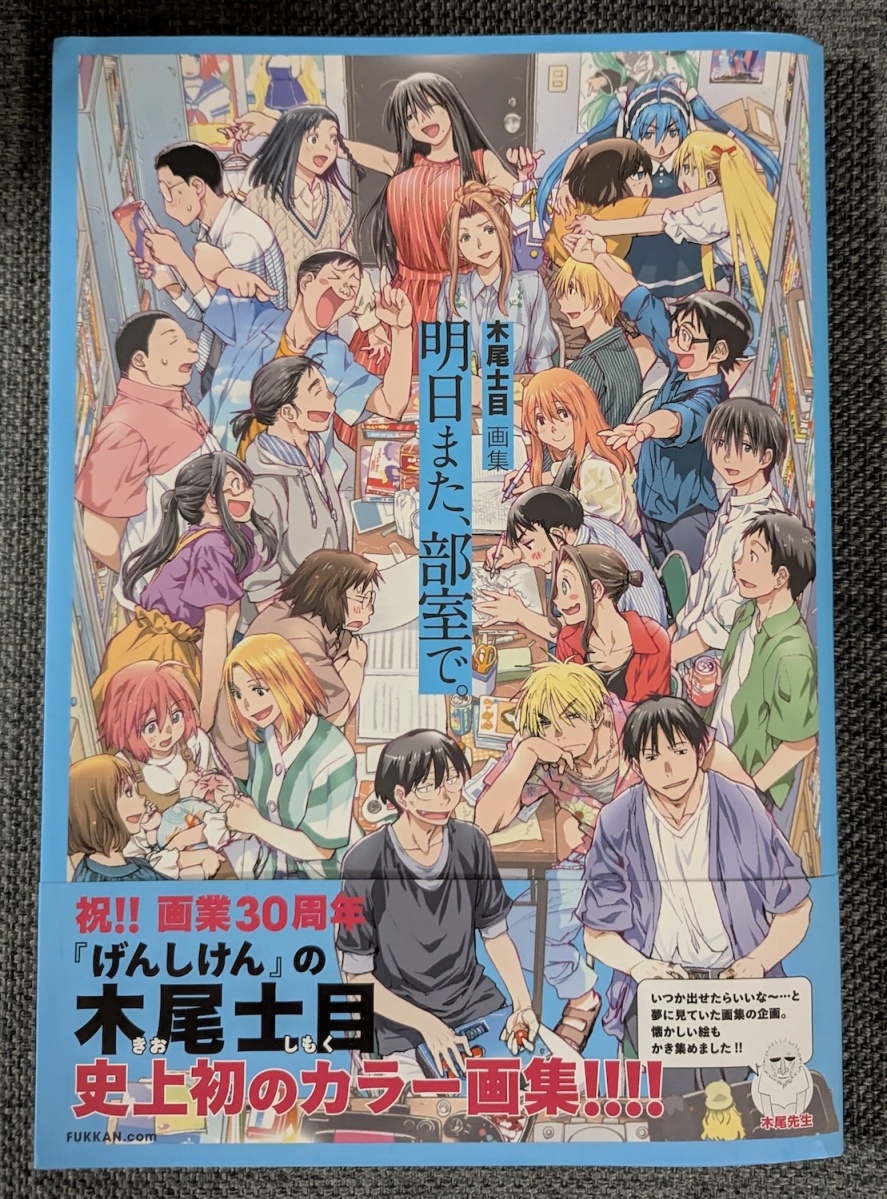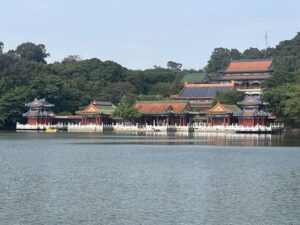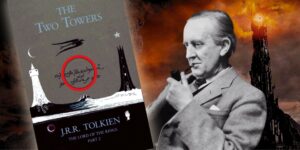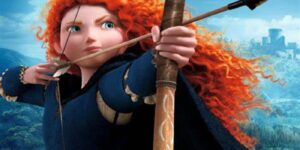“Kio Shimoku Art Collection: See You Tomorrow in the Clubroom” Review and Interview Notes

Today is the birthday of Ogiue Chika, the namesake of this blog and my favorite character from my favorite manga, Genshiken. In celebration of this, I have decided to finally write something about the author’s recent 30th anniversary artbook titled Kio Shimoku Gashuu: Mata Ashita, Bushitsu de (Kio Shimoku Art Collection: See You Tomorrow in the Clubroom).
First, this artbook is almost everything I hoped for: large illustrations from throughout my favorite manga creator’s career. Second, there’s an extensive interview at the end, and I’ve jotted down all the notes from it that I could. It’s actually the vast majority of this post!
Whether it’s his old analog paintings to his digital work, you get to see how his style has changed. This is especially the case with his Genshiken pieces, and a part of me does miss the look of those early works. Nevertheless, it all looks great, with high-quality reproductions of even things like DVD box sets. A lot of merch I never got, I can at least have their art. Kio actually re-scanned a lot of it!
The illustrations also include guest art for anthologies and such:
- Horizon in the Middle of Nowhere
- Gundam: The Origin
- Ashita no Kyouko-san
- Yuruyuri
- FotoKura
- Night on the Galactic Railroad Musical
Only thing that’s missing is Spotted Flower, though I’m sure Kio would have included it if he could.
So this is naturally highly recommended for Kio Shimoku fans.
And now, here are all my notes from the interview. It even includes comments about Kio’s wife, whom he pretty much never talks about!
Early Life and Family
Kio Shimoku was born in Shizuoka in 1974, and moved to Tokyo when he was two years old. He attended kindergarten in Kokubunji, Tokyo. In elementary school, he moved to Chiba Prefecture and spent a large chunk of his life there, to the extent that he strongly identifies with Chiba. He was in Chiba through high school and went to Tokyo after college, but then returned to Chiba.
Two of his manga, The Fourth-Year (Yonensei) and The Fifth-Year (Gonensei), are set in Kisarazu, Chiba because Kio went to college there and thought it’d make for easy reference material.
Kio’s dad worked for an insurance company, and didn’t really oppose him becoming a manga artist. His mom was a housewife but used to be an office worker. He has a brother who’s six years older, so there’s kind of a generation gap between them. A lot of the manga Kio read as a kid was his brother’s: Jump titles like Black Angels, Cat’s Eye, Ring ni Kakero. The manga that he bought himself were Captain Tsubasa, Dr. Slump, Hokuto no Ken, JoJo. The biggest title for him was Doraemon, and he remembers drawing doodles of Perman’s helmet.
Against expectations, he actually more of an outdoors kid. His dad did judo, and he lived in a rural area in Chiba. Kio’s activities included bug-catching and going to the beach. He also practiced judo himself in middle school, which has made it easy to depict characters that do the same (like Hato from Genshiken Nidaime).
But as active a kid as he was, Kio still liked to read and draw. He was there for the Famicom boom, and his #1 indoor hobby was Gunpla. His brother bought Gundam and Guncannon kits and gave the Guncannon to him. He played with the kits before he ever saw Gundam, which he eventually did when he saw the original movie trilogy. Kio wanted Gunpla so badly that he drew his own imaginary modeling store—not the model themselves but the store in which he’d buy them.
Some other titles he liked: Esper Mami (he was influenced by its SF flavor), Fujiko Fujio’s Land (he liked all the nude scenes), Bouken Gabotenjima, Scramble Egg (it was one of his brother’s books).
Another big one was Plamo-Kyoshiros, which was his “Bible,” especially with all the customized Gundam model kits it showed. He used all the tech he had available to him at the time on a Qubeley, and then stopped after just the one. Master Grades came out when he was in college.
Nausicaa of the Valley of the Wind was also a huge influence from elementary to high school. He would trace over Miyazaki’s art and tried to draw just like him, but found it difficult as a kid to the point of being discouraged, thinking, “I have no talent!” In middle school, though, Kiki came out and he found he could draw like Miyazaki a little better. Drawing and painting using watercolors, he thought he might have what it takes.
A friend of his asked if he wanted to make a manga together, and Kio agreed. That same friend is the one who taught him about manga tools, like nib pens. Kio volunteered to do backgrounds, and was inspired by Oga Kazuo and Yamomoto Nizou. He had an interest in fine arts, but it’s not like he never drew characters. There was a particular drawing of Elpeo Ple from Gundam ZZ next to a bicycle, with a seiso expression and wearing a beret, that he really liked. He’d focus especially on Ple’s face when trying to replicate it. He learned to do eyes from copying the artist who drew it, Kitazume Hiroyuki.
In his third year of middle school, Animage started releasing Roman Albums and Art of books, and it made him want to become an animator. However, he was sad to discover that you had to be at least 18, and gave up.
College Life and Becoming a Manga Artist
In high school, he seriously pursued trying to become a manga artist because by that time, he found that he could handle all aspects of manga making himself. He got so into making manga that he basically missed out on the entirety of the Super Famicom/Game Boy boom.
At 17, Kio got a newcomer award in Sunday magazine. As for why he submitted to Sunday instead of Jump, It was around middle to high school that he became more of a fan of the former. The first Sunday manga that caught his attention was Kyuukyoku Choujin R. Then there was Obi wo Gyutto ne by Kawai Katsutoshi, which actually showed fanart at the end of the collected volumes. His art was published three times, but he never managed to win an autographed signboard. But when he contributed to Kawai’s mook, he actually got the autograph, which made him really happy. Other big titles he read at the time were Ranma ½, Spriggan, Patlabor, Ghost Sweeper Mikami, and Ushi and Tora.
His first submission to Sunday was about a boy who worked at a secondhand bookstore, except the “secondhand books” were actually stolen goods. Kio thinks it was a pretty plain and unspectacular idea. He liked secondhand bookstores, and would go into them whenever he saw one. He also tried to draw manga of the adventurous kind in the vein of Studio Ghibli. There was one that got to 50 pages of the manuscript, but he never finished it. The thing really just consisted of whatever came to mind as he was making it.
When asked why he prefers to make more everyday life works than dramatic stuff, Kio says that while his artistic path began with Miyazaki anime, it’s the portrayals of everyday life in Miyazaki’s works that he built on.
Kio had worked with Sunday, but he never debuted with them. This is because he couldn’t keep working with his editor there. Kio was asked to do things like come up with 10 new ideas before their next meeting, and he just found it impossible.
If he had debuted with Sunday back then, he wouldn’t have gone to college. But he did while majoring in Nihonga (Japanese painting) at University of Tsukuba. At the interview to get into the university, he lied and said that he really wanted to become a Nihonga artist. He chose Nihonga because he thought he could transfer the brush skills he learns to making manga. Western painting tools like charcoal aren’t really used in manga. He worked on manga while also doing his college work.
He was in the dorms his first year but lived on his own in an apartment for years 2 through 4. He and his friends would go over to each other’s places and hang out and eat. There was really nothing to do at Tsukuba in the 90s. The Tsukuba Express didn’t even exist back then. Students would hear noises and swear other students were having sex. (Not much else to do otherwise, in terms of gossip.)
Kio had lots of good friends but not a group of otaku he was close with, like in Genshiken. However, he had one senpai he looked up to, who had a lot of esoteric otaku knowledge and was really mature. Tanaka is partly influenced by him.
There was a University of Tsukuba Society for the Study of Modern Visual Culture which is the name basis for Genshiken, but Kio only was a member for half a year. He did draw a sign for them as a first-year for a culture festival in autumn, but he doesn’t remember exactly what he drew.
He’s not a fan of huge gatherings and so what he mostly did was hang out with 3 to 4 people and play fighting games. Later, his editor at Afternoon said to Kio that it sure seems like Kio had a fun college life, to which Kio agreed that maybe he did.
Kio’s Early Manga
Kio is asked if the darkness in his early works from Ten no Ryouiki (his debut title) to The Fifth-Year was a reflection of his school experience, to which he replies that he’s not really sure. At that time, he would put everything he was thinking about into his manga, and his work reflected that. He is the type to dwell and ruminate on things to the point of self-loathing, and he thinks the way he approached the subject of romance came from that. He combined his own experiences with stories he heard from others, though he says he did not have a very active love life personally.
Kio did not originally plan to be a manga author who focuses on romance and relationships, and Kio Shimoku was meant to be a one-off throwaway pen name. He wanted to do action instead. Ten no Ryouiki was meant to be practice. Looking back, it actually turned out to be just that.
He wanted to do an entertainment-focused Eastern culture action series next in the vein of Shirow Masamune’s Orion or Fujisaki Ryu’s Hoshin Engi. But when he looked at his old rough manuscript for it, he’s glad he didn’t.
Genshiken was born out of wanting to make something with more entertainment value, and both Kio and his editor at the time felt like Genshiken could work. However, he didn’t feel particularly enthusiastic about it because he thought he’d end up getting bashed for it. In fact, up until serialization, he was trying to avoid it. He even drew the short manga Krakatit no Machi during that time.
The Town of Krakatit (a dark and obtuse work) is named after the novel Krakatit by Karel Čapel, and Kio thinks the book might have really struck a chord with him back then, or perhaps he heard that the novel was similar to his idea. He does remember being asked by another manga creator at an end-of-year party why in the world he decided to make a story like that. It was right before Genshiken’s serialization and Kio wanted to forget everything. He’s still not sure what he was feeling, but maybe it was a desire for total ruin.
Both The Town of Krakatit and The Fifth-Year have violent climaxes. Kio didn’t intend or want for The Fifth-Year to involve an attempted stabbing, but he felt that it had to go there based on how the story developed. For Krakatit no Machi, it was because he wanted to draw a more heavy-set character. The interviewer points out that Kio has drawn a lot of fatter characters over the years.
Genshiken and a Stylistic Change
In regard to his changing style, especially from the early works to Genshiken, Kio says it was a conscious choice to improve the entertainment factor of his manga. However, you can tell that it’s still in a transition period in Volume 1 of Genshiken based on the art. As for how exactly he tried to change his art style, Kio worked towards a more semiotic way of drawing, where the designs convey who the characters are. Kugayama was the earliest design.
Kio chose their characteristics by drawing random lots (kujibiki) and building from there—something he only rediscovered recently after finding an old memo. For example, with Madarame, he got “bowl cut” and “glasses,” and decided what he’d be like based on that. Of course, when finalizing the character, he didn’t leave it to chance. He feels that Madarame, Tanaka, and Kugayama are the most successful designs in terms of semiotics, but with Sasahara, he actually forgot to design him until the last moment. Sasahara ended up being made with no strong features because he was supposed to be the character who first enters the club.
The premise of Genshiken actually began with the love triangle of Madarame, Saki, and Kohsaka. Kio realizes that they’re basically Maeno, Takeda, and Kyouko from Ping Pong Club. It wasn’t intentional, but looking back, it was a dynamic he loved. Ohno was originally designed to be more cringey, but based on the trajectory Genshiken took, he decided to go for someone who would be more popular with readers. Now, he realizes she’s essentially just Kamiya from Ping Pong Club.
Kio is glad that people say his portrayals of otaku reflect the times. His starting concept was wanting to draw otaku as normal people. Genshiken is a work from the period after the one where otaku were getting bashed the hardest. Kio didn’t want to have messy relationship stuff in Genshiken, but couples ended up happening anyway. He thinks this makes things feel more real.
He didn’t do any research for Genshiken’s first generation, but for the second gen, he attended Comiket and interviewed circles that were aimed towards female audiences and even sat in circle spaces all day. He got to hear conversations between creators and customers as a result.
However, he has participated in Comiket as a creator before. This was because Ogiue was tabling at ComiFes in the manga, and Kio felt he needed to experience it firsthand. He considers himself an otaku, but he actually hasn’t gone to Comiket much. The reason is that he winds up buying too much other porn because he loves horny art. In fact, he originally bought a Mac instead of a Windows PC so he wouldn’t end up buying so much eroge.
In response to the unanticipated developments that came with Ogiue’s character, Kio says he never thought the story would go in the direction it did. He did create Kugayama as someone who draws, but he’s not supposed to be particularly good at it. Ogiue was created because the story had plenty of otaku-as-consumer characters but not otaku as creators. She was a challenge to work with, but it was incredibly fun.
Genshiken was planned to be a manga that ran in real time, so with a new chapter every month, a month would have passed in the series. However, with Ogiue’s arc, the timeline kind of went out the window and time had to pass at an accelerated rate in chapters 50 through 54 so that the series could end during graduation season. Some of the stories during that time ended up in the extras of the volume releases.
Into Kio’s Psyche
The interviewer points out that Kio has a lot of scenes of characters expressing fear at the prospect of revealing their true selves to others: Ogiue and Hato in Genshiken, but also in The Fifth-Year. Kio didn’t remember that he had a scene like that in The Fifth Year, but he believes this is something connected to his fundamental way of thinking. Even his erotic doujinshi Zenbu Sensei no Sei (and its sequel) feature a girl (and later her mom) learning about who they “really are.”
The interviewer also describes Genshiken as a story that began with entertainment in mind only to dig deep into people’s very beings, which seems to be a real Kio Shimoku–ism. Kio says that Genshiken is a work that even when trying to summarize it offers resistance. It’s also the work he’s re-read the most out of his own creations, first for Genshiken Nidaime and now occasionally for Spotted Flower. Kio believes that Genshiken was such a good thing for him that the rest of his life is just extra change.
In terms of the portrayal and exploration of sexuality, Kio didn’t intend for it to be indicative of the time. The belly band on the Japanese Volume 8 originally said “The Love of Otaku,” but Kio asked to change it because he wasn’t trying to show a normal portrayal of love. Rather, it was about exploring all the various characters’ individual ways of love. This idea later applied to Hato as well.
As for how the character of Hato came to be, he knew early on that he wanted Nidaime to focus on a mainly female cast, but that he wanted one male character. Kio had in mind two possibilities: a guy who looked like a girl (i.e. Hato) or a big but gentle-feeling dude, like Yamada’s dad in The Dangers in my Heart. He made two rough manuscripts, one for each character, with the former ending up going ridiculous places and the latter being pretty normal. But then, Kio learned that there are ways for men to change their voices to be more feminine, and it all clicked. Kio has at times kind of wanted to become a girl himself, so he put that in there too.
The interviewer thought Madarame would actually start dating Hato. Kio drew the Madarame romantic prospects thing to just see where it would end up, and he originally thought it would be that the guy gets with no one.
Kio and His Wife
Sex and love have always been a part of Kio’s work. His wife, Kami-san, described Genshiken as low-energy horny. Kio starts from the fundamental idea of “I myself am horny.” He actually was seen drawing porn in middle school by his family, and he thinks this trauma may have made him unable to draw erotic art for a long time. This repression may be what undergirds his work. His work might not be about sex but rather about masturbation in the sense of knowing what you individually desire. This is where the notion that “drawing manga is a form of masturbation” enters his thoughts. Masturbation comes up in multiple works of his, and Kio thinks it has to do with wanting to hide your real self.
Kio got married in 2000, and it’s a year he can recall with ease. It was a time when his manga wasn’t really selling, and he decided to get married without putting any thought into it.
He met his wife in college. She’s actually the first person he showed his rough manuscript of Genshiken, before even his editor. At the time, it was because he wanted to make a manga about otaku that appealed to normal folk, and she was the test case. Her impressions ended up in Saki to a degree as well, like the way Saki pronounces the word “anime.”
Kio showed his wife Nidaime early on, but can’t quite remember when it comes to Hashikko Ensemble. He did not show her Spotted Flower, but Kami-san did remark that it was probably just Kio and the Rakuen editor Iida-san doing whatever the hell they want.
Jigopuri wasn’t well received, but Kio felt that baby-raising was the only thing he could make manga about at the time.
Kio relates to characters like Madarame who feel like they never really grow up. He feels that even when he’s an elderly old man, he won’t feel like an adult.
Kami-san is into classical music, and took Kio to watch a men’s choir. Afterwards, she said to him that this could be good subject matter for something, though she was thinking about it more like BL involving working adults. Kio was working on a different plan at the time, but when he brought up the men’s choir idea to his editor, it got the okay, with the technical high school at the backdrop. This makes it different from all his previous college-set works.
Because he didn’t have much experience with the subject, Kio had to do a lot of research. To portray the singing, he employed various techniques like using different density of tones for high and low notes, employing gradients on lyrics, layering text when multiple people were singing, changing opacity levels, etc. He did all this with satisfaction.
Right now, he doesn’t have any new ideas he really wants to draw, or at least things he thinks he has time for. On a personal level, he did do Sister Wars lately. The idea for it actually came from his wife, who misspoke slightly and said “Si…Star Wars.” From there, they joked about how Sister Wars sounds like an eroge, that the Jedi would all be girls, and the Padawans would go, “Onee-samaaa!” Though it’s not as if Kio is a super-huge Star Wars fan.
The release of the art book makes him feel the full extent of his 30-year career in manga, even if it doesn’t include Spotted Flower.








